How To Change A Filename That Is Too Long
If you've ever seen this upshot, it was probably a simple fix for you. If you lot've seen this error more than than twice, then you also know that it can be a complex issue to fix sometimes.
Let'southward promise you simply run into the like shooting fish in a barrel set up variety, but nosotros'll ready you lot for the less easy, guaranteed to work fixes too.

Why Is Filename Length Fifty-fifty An Outcome In Windows?
In that location's a long history of filename lengths being a problem for operating systems like Windows. In that location was a fourth dimension when you lot couldn't have filenames longer than 8 characters plus a 3-character file extension. The best yous could do was something similar myresume.doc. This was a restriction in place by the design of the file organization.
Things got better every bit new versions of Windows came out. We went from an one-time, limited, file system to something called the New Engineering File System (NTFS). NTFS took us to a point where a filename could be 255 characters long, and the file path length could potentially go up to 32,767 characters. So how can nosotros perhaps have filenames that are too long?

Windows has things known equally organization variables. These are variables that Windows relies upon to part, because Windows will ever know what the variables hateful and where they are, even when nosotros're moving bits and bytes all over the place. The system variable MAX_PATH is the i that restricts filenames and file paths to under 260 characters.
Being a variable, you'd think nosotros could change it. No, nosotros should not. It would be like pulling a thread out of a sweater. As soon as one system variable changes, other system variables and components dependent on them offset to unravel.
How exercise we fix it, then?
The Easy Fix
If yous're fortunate, you'll get the mistake and know exactly what file'due south proper noun is causing the result. Or at least where to detect the file. Maybe y'all take a filename that looks something like:
C:\User\guymc\Documents\My Resumesresumewithanamesolongthatitcausesproblemsandbecomespartofsomeguysarticleonthewebhowdoyoulikemenow.docx
It's obvious who the offender is in this case. Find the file in Windows Explorer, or File Explorer every bit it's called in Windows 10, click in one case on it, hit F2 to rename it, and modify that silly filename to something more than reasonable. Problem solved.
The Less Easy Fixes
It isn't e'er that easy to fix this trouble. Sometimes you may not be able to modify the names of files or directories for whatever reason.
The following solutions volition practise the trick for yous. They aren't hard to do.
Motion, Delete, Or Copy Files Or Directories Using PowerShell
Sometimes you go an error when trying to movement, delete, or re-create directories where the graphic symbol count for the file path is more than 260.
Note that the words directory and folder are interchangeable. We'll utilize 'directory' going forwards. The following PowerShell cmdlets tin also be used on files.
Perhaps the file path looks something like:
C:\Users\guymc\Documents\This\Is\Exactly\The\Precise\Directory\Path\That\I\Demand\To\Take\To\Go along\My\Files\Sorted\In\A\Style\That\Makes\Sense\To\Me\And then\Lets\Pretend\This\Is\An\Actual\Filepath\That\You lot\Might\Too\Have\On\Your\Windows\Reckoner\And\Not\Over\Retrieve\Information technology\Document.docx
That file path is 280 characters long. And so we cannot copy the directory out of at that place to somewhere else with the normal copy-paste method. We get the Destination Path As well Long error.
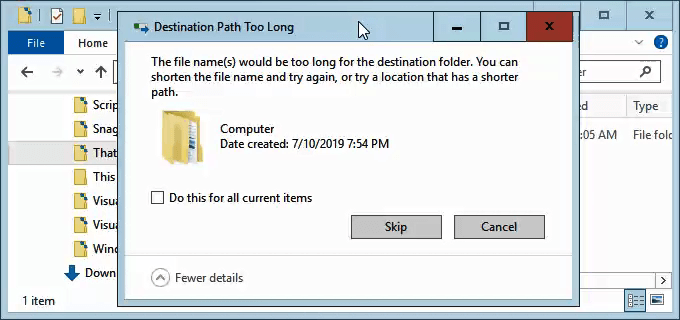
Let'due south assume that for any reason, nosotros tin can't rename the directories in which the file is nested. What practice we practice?
Open up PowerShell. If you haven't used PowerShell yet, bask our article Using PowerShell for Habitation Users – A Beginner's Guide. You can practise the adjacent steps without reading the article, though.
When PowerShell opens, you lot'll be at the root of your user directory. Follow forth assuming C:\Users\guymc is your user directory.
The directory named This is within the Documents directory. To move into the Documents directory, nosotros use the DOS control cd Documents.

You'll see the prompt change to C:\Users\guymc\Documents. That'due south good. Nosotros're working closer to the directories which volition brand things easier.
Copy Directory Using Copy-Item
We want to copy the directory This and its contents into ThatNewFolder. Permit's utilize the PowerShell cmdlet Copy-Item with the parameters -Destination and -Recurse.
-Destination tells PowerShell where we desire the copy to be. -Recurse tells PowerShell to copy all the items inside to the destination. Copying leaves the originals where they are and makes all new ones in the destination.
Copy-Detail This -Destination ThatNewFolder -Recurse

Move Directory Using Motility-Item
Let's say we want to motion the directory This, and all the directories and files in it, to ThatNewFolder. Moving does not leave the original in identify.
We can use the PowerShell cmdlet Motility-Item with the parameters -Path and -Destination. -Path defines the item nosotros want to move and -Destination tells PowerShell where we want it.
The cmdlet volition put This inside of ThatNewFolder. It will also move everything that is inside of the This directory. Motility-Item tin be used to motility files or directories, and it works regardless of file path or filename length.
Move-Item -Path This -Destination ThatNewFolder

To make certain it worked, use the cd ThatNewFolder command to get into ThatNewFolder. And then utilise the dir command to list the directories in ThatNewFolder. You'll come across the This directory is in at that place.
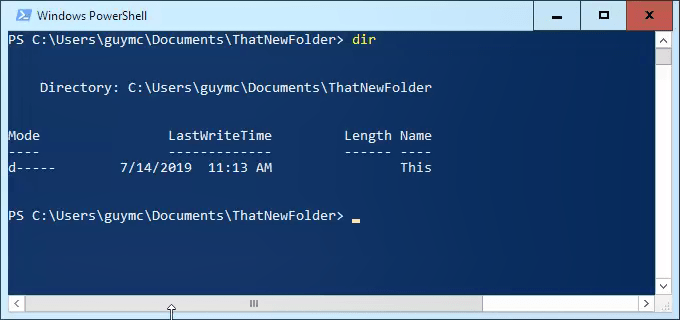
Delete Directory Using Remove-Detail
If we desire to delete the This directory, and everything in information technology, we use the Remove-Item cmdlet.
The Remove-Particular cmdlet has some congenital-in prophylactic that makes it difficult to delete a directory with things inside of it. In our example, we know we want to delete everything, and then we'll use the parameters -Recurse to make information technology delete everything inside and -Force to make information technology practice that without request us if we're sure for every item inside.
Be warned! Recovering anything deleted this manner would be extremely hard. You can try the methods in How to Recover Accidentally Deleted Files, merely don't wait much.
Remove-Item This -Recurse -Forcefulness

You can use the dir command again to make sure it is gone.
Brand Windows x Accept Long File Paths
If you know y'all're going to exist using long file paths and long file names repeatedly, information technology's easier to make Windows work for you. No sense using PowerShell to do the work every day.
There are two ways we can practise this. One is for Windows x Dwelling house users and the other is for Windows 10 Pro or Enterprise users. These methods may work for Windows viii.1 or before, just nosotros cannot guarantee that.
Make Windows 10 Home Have Long File Paths
To brand Windows 10 Domicile accept long file paths, nosotros need to open the Registry Editor. If you haven't worked in Registry Editor earlier, exist cautious. Accidentally deleting or irresolute things in hither can stop Windows from working completely.
Always brand a backup of your registry before making any changes. Learn everything you need to know about that in our Ultimate Guide to Backing Up and Restoring the Windows Registry.
Once yous have Registry Editor opened, and your backup made, navigate to the location HKEY_LOCAL_MACHINE\Organization\CurrentControlSet\Control\FileSystem and find the central LongPathsEnabled.

Double-click on LongPathsEnabled. In the Value information: field, brand certain the number 1 is in there. Click OK to commit the alter.
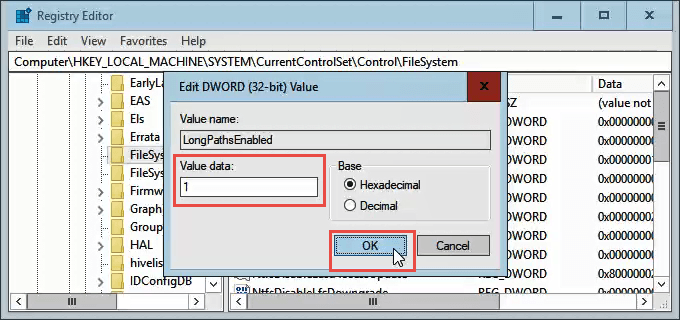
Exit Registry Editor and yous should be able to work with crazy long file paths now.
Brand Windows 10 Pro Or Enterprise Have Long File Paths
To allow Windows 10 Pro or Enterprise to apply long file paths, nosotros're going to use the Group Policy Editor. It's a tool that allows united states to set up policies on how Windows operates at the computer and the user levels.
We've got several manufactures on using group policy to practise things like disabling or enabling Internet Explorer options, or adding a bulletin to the logon screen.
Open the Group Policy Editor by going to the Start carte du jour and typing in gpedit. The top result should be Edit group policy. Double-click on that.
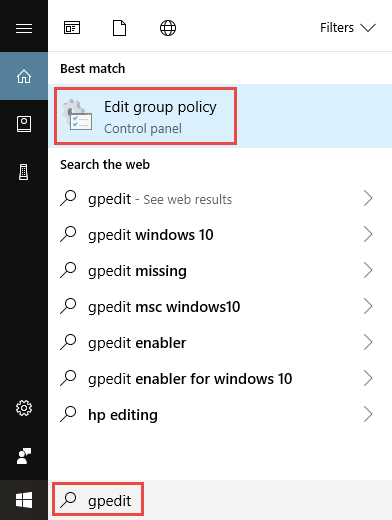
Once the Group Policy Editor opens, navigate to Figurer Configuration > Administrative Templates > Arrangement > Filesystem. At that place you'll meet the policy Enable Win32 long paths.
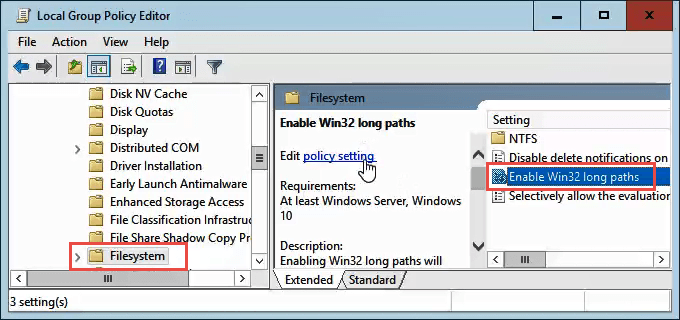
Double-click on it to edit the policy setting. Change it from Disabled to Enabled, then click the OK push button to commit the change.
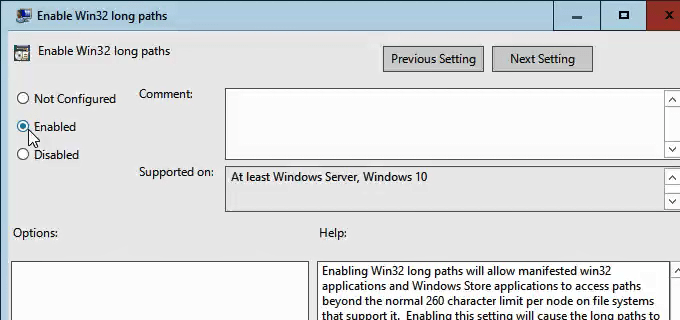
The policy may not have effect right away. You can force the group policy to update, though.
That'south It
There are another ways to work effectually long filenames and file paths, only what we've gone through hither are the simplest, well-nigh constructive methods.
Do non share my Personal Information.
Source: https://helpdeskgeek.com/how-to/how-to-fix-filename-is-too-long-issue-in-windows/#:~:text=Find%20the%20file%20in%20Windows,Problem%20solved.
Posted by: wardheasuffee.blogspot.com


0 Response to "How To Change A Filename That Is Too Long"
Post a Comment